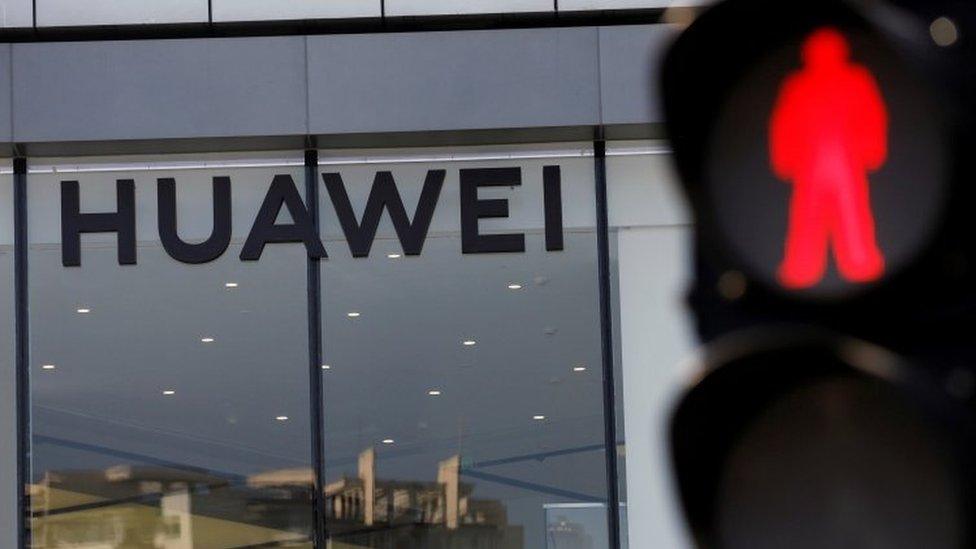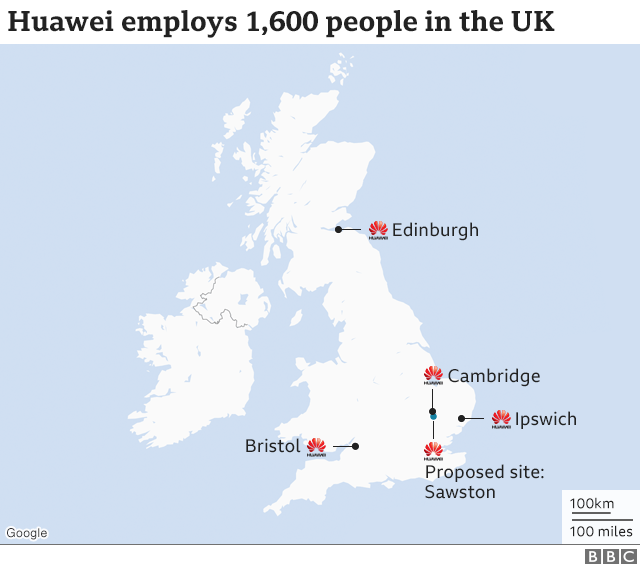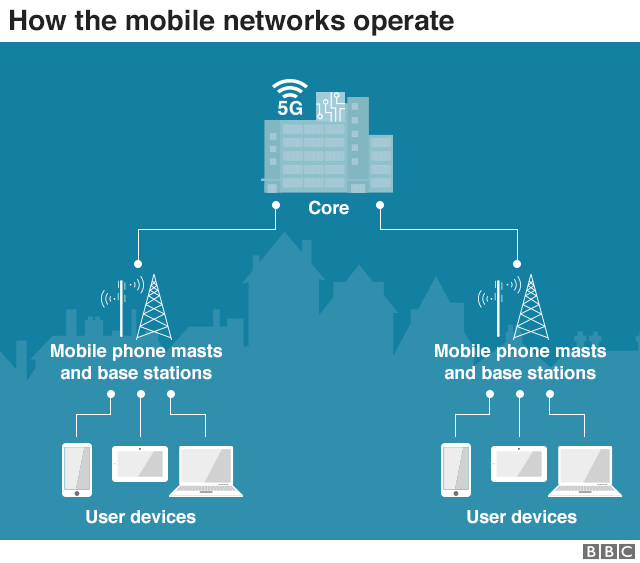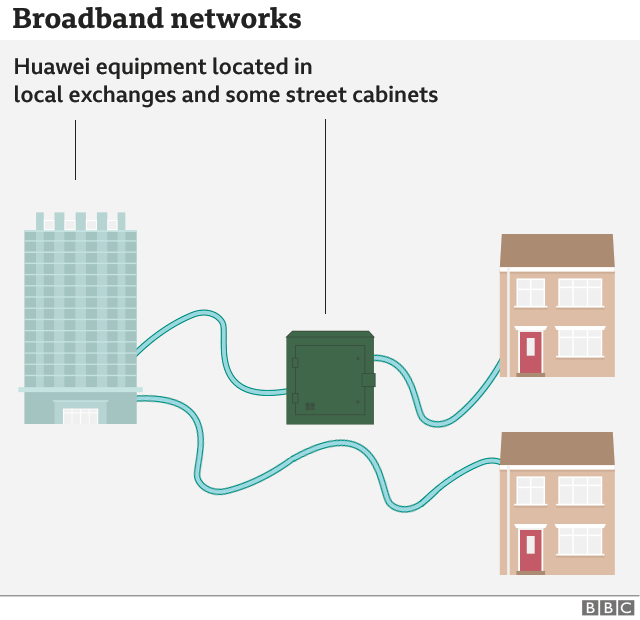Huawei: What does the ban mean for you?
- Published

The UK's decision to ban Huawei's 5G kits from use in mobile networks and to also stop using its equipment in full-fibre broadband networks is not without consequence for the country's internet users.
As the Digital Minister Oliver Dowden acknowledged, the decisions will have "consequences for every constituency in the country".
The Chinese firm itself has claimed customers will face bigger bills as a consequence of the billions of pounds that will be spent ripping out its kit and moving to other suppliers.
And there could be further consequences for the wider economy if Huawei diverts its research and recruitment funds elsewhere, not to mention other Chinese companies that might now see the UK as a less friendly market.
Will this mean my Huawei phone stops working?
No.
The move affects the equipment at radio masts and inside telephone exchanges that operators use rather than individual consumer devices sold by the firm.
"It doesn't directly affect the Huawei technology you use at home, such as smartphones, laptops and tablets," explains the National Cyber Security Centre (NCSC).
"All your apps should continue to work, and your phone/laptop/tablet should keep getting security updates for its normal lifetime."
But the new US sanctions do restrict Huawei's ability to get its own chip designs manufactured, which in turn may slow the pace it can make improvements to its hardware. In addition, other restrictions mean new Huawei devices cannot offer Google's services, including its Play Store and smart assistant.
Will it affect my 5G service?
Possibly.
Vodafone, Three and EE had all begun rolling out 5G services reliant on Huawei's kit nationwide, and they now face having to replace it with equipment from another vendor.

Mobile operators are likely to take longer to rollout 5G across the UK as a consequence of the new measures
Vodafone and EE had previously indicated that if given less than five years to do so, their customers might face mobile coverage blackouts. But the 2027 deadline gives them more time.
However, Mr Dowden acknowledged that a requirement to stop buying new Huawei kit by the end of this year would slow down the wider rollout of 5G by a year. And he added that when one takes into account the 2027 ban and earlier restrictions imposed on the use of the firm's technology, the cumulative delay would be "two to three years".
That means 5G will remain patchy for longer than it would have done and some parts of the country will have to wait longer to get any access to the next-generation service.
Does it mean my broadband is going to suffer too?
Perhaps.
In the last election, one of the government's flagship pledges was gigabit connectivity for all by 2025.
That involves connecting properties directly to local phone exchanges with fibre - which was already a hugely challenging task to carry out nationwide.
As part of its recommendations, NCSC has said that Openreach and other broadband infrastructure providers should stop deploying Huawei's "fibre access equipment" - meaning the kit in local exchanges that handles and routes data as it arrives and departs, rather than the internet routers in people's homes.
But there is a problem: a present Nokia is the only other supplier of some of the kit involved.
And NCSC has warned that the risks involved in a shift to a single vendor outweigh those of continuing to use Huawei for the time being.
The government intends to discuss the matter further with operators and hopes at least one other kit provider can be fully substituted for Huawei within two years.
But if they struggle to identify one, then security chiefs have explicitly said that once the US sanctions fully kick in, they might be "unable to gain sufficient assurance in these products to mitigate the risks".
In other words, the UK might have to slow down the rollout of gigabit broadband and miss the government's target.
Are my bills going to go up?
It's too soon to say, although talk of £2bn in added costs do not bode well.
In terms of mobile, the Telegraph has reported that the networks are hoping, external to offset added costs by convincing the government to make it cheaper for them to buy the airwaves necessary to provide 5G services.
But if less money flows to the Treasury as a consequence, taxes might have to go up to compensate.
In terms of broadband, it depends whether Openreach experiences higher costs of its own in sourcing products from new suppliers, and then feels the needs to pass those onto individual internet service providers (ISPs).

Huawei's UK research bases
One consequence of shunning Huawei is that it might lead the company to rethink its research and development investments in the country.
The firm has sponsored work at several universities including Imperial College, London, Southampton and Surrey.
In addition, it operates research centres of its own employing a total of 400 people in:
Edinburgh
Bristol
Cambridge
Ipswich


The company also recently gained planning permission to build a new £1bn research centre at Sawston - a large village to the south of Cambridge. It has said the development would create hundreds of further jobs.
But one expert said the new restrictions might not mean the project will be abandoned.
"The research centre in Cambridge has been many years in the planning, and may well be its future sourcing of important technologies within the global supply chain, so Huawei might want to keep it if it is allowed," said Emily Taylor from the Chatham House think tank.

Where is Huawei's kit used in UK?
Mobile networks can be divided into two parts: the core and the radio access network (Ran).
The core is likened to the brain and carries out the most sensitive operations, including authenticating users' identities and making sure calls get sent to the right radio tower to connect to another person's phone.
The Ran includes the base stations and antennas used to provide a link between individual mobile devices and the core. Insiders sometimes describe this as the "innovative but dumb" part of the network.


BT's EE mobile network features Huawei in the core of its 4G and 5G networks, but the firm is in the process of replacing it with Ericsson's products, and has promised to do so by the end of 2023.
Otherwise, the UK's main mobile providers only use Huawei in the Ran, and then always as part of a mix with at least one other vendor:
EE to provide 2G, 4G and 5G
Vodafone to provide 2G, 3G, 4G and 5G
Three to provide 4G and 5G
O2 to provide 5G at a relatively small number of sites in London, where it tested the equipment before opting to go with other suppliers elsewhere
Huawei also provides broadband equipment to BT's Openreach division, which owns the infrastructure used by other ISPs, including Plusnet, Sky and TalkTalk.


These days, the focus is on rolling out fibre-to-the-premises (FTTP) connections, which offer the fastest speeds and are key to delivering the government's "gigabit for all" 2025 pledge.
In this case, Openreach uses Huawei's kit at what it calls the "headend" - a gateway at local telephone exchanges that converts electrical signals to and from light-based ones, and makes sure each customer's data is sent to the appropriate ISP.
Many people still get their internet via slower connections, which are routed via intermediary street cabinets.
About 70,000 of these cabinets contain Huawei's kit, and the data also passes through more of the Chinese firm's products at local exchanges.
Openreach does not, however, use Huawei's equipment in its core.
Elsewhere, CityFibre - which runs its own smaller full-fibre networks - uses some Huawei gear as a legacy of an acquisition, but intends to strip it out by mid-2021.
Virgin Media does not use Huawei's equipment within its broadband network.
But it does use it to provide telephone services, both for internet-based landline calls as well as to provide mobile phone subscriptions.
Other mobile virtual network operators (MVNOs) - including Sky Mobile - also use Huawei's gear.
It effectively sits between each MVNO and the mobile network whose infrastructure is used, and helps calculate customer bills, among other IT services.